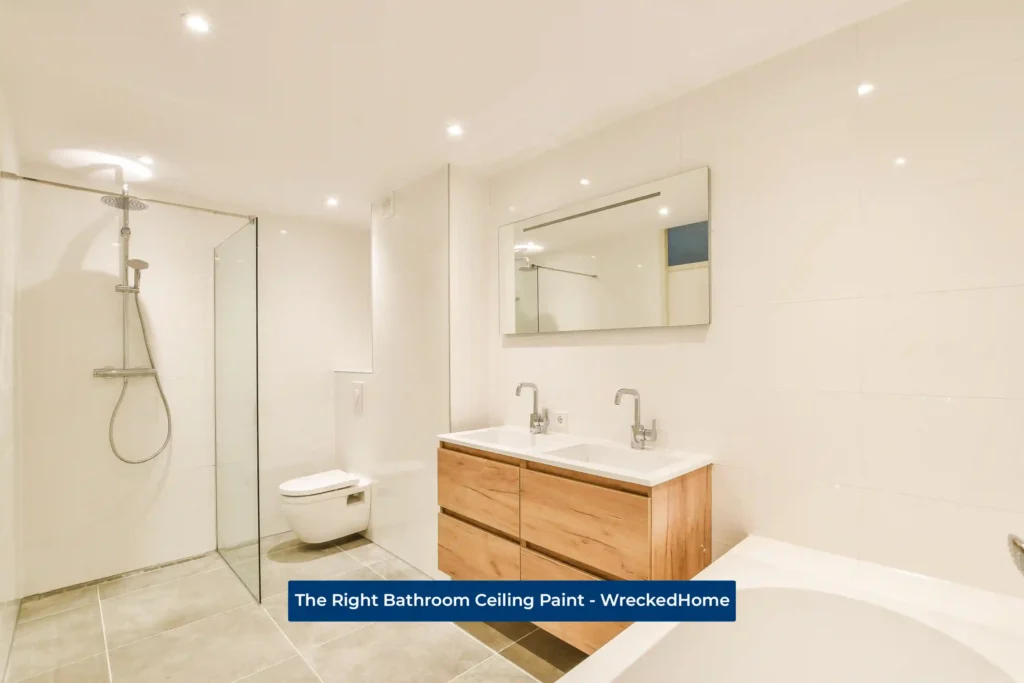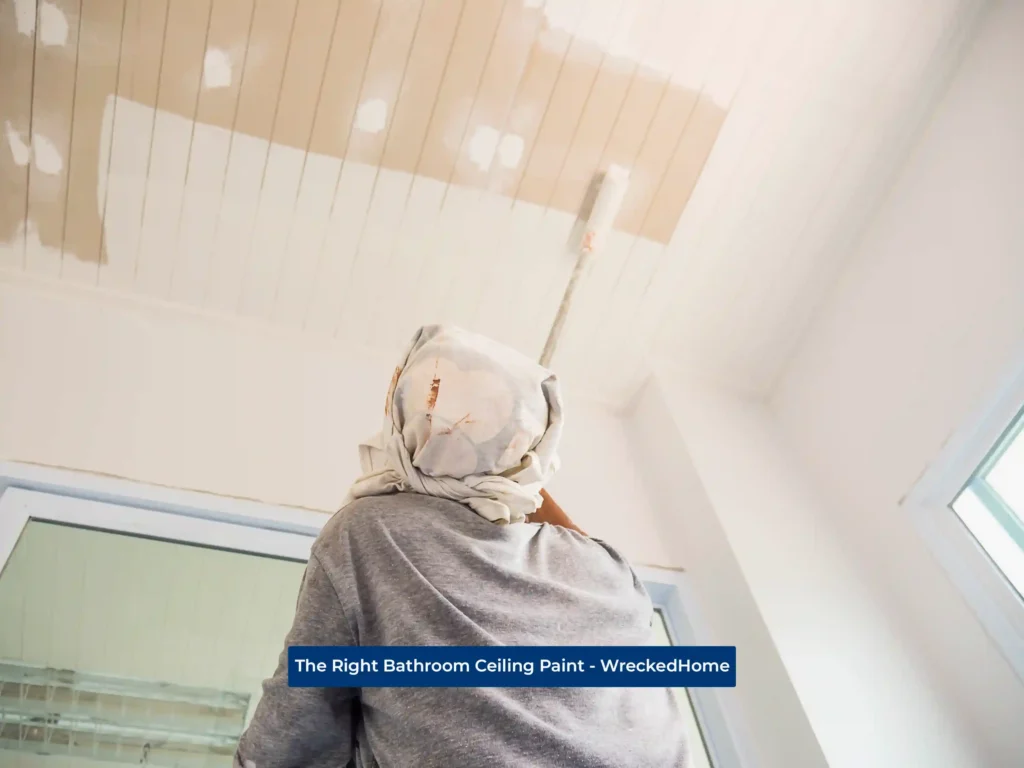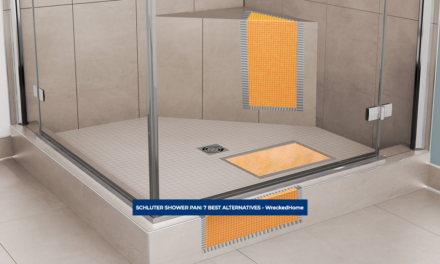The bathroom is an important part of your home. It serves as a space of relaxation, and often, the first place you visit at the start of your day. If you are fatigued and want to take a shower then a calm bathroom is the place to go. The bathroom ceiling is an often overlooked element that should be perfect. Do you know how to make it perfect with bathroom DIY?
Don’t worry, the basic element of that ceiling perfection is the color of the paint. The right bathroom ceiling paint is not only known for aesthetics but also for its functionality. Bath paint faces different challenges as compared to other rooms. Therefore it requires extra effort to choose.
Some of the common challenges include humidity from hot showers, unexpected moisture splashes, and frequent temperature fluctuations. You need to do proper research to pick the best bathroom ceiling paint. The wrong choice will lead to the unsightly peeling, mold growth, and a faded appearance.
If you are curious how to choose the right paint then this guide is for you. Here, we will discuss environmental conditions and challenges that bathroom faces. You will also get to know how to pick bathroom ceiling paint and ensure longevity.
Why Bathroom Ceilings Need Special Consideration:
Bathrooms stand apart from other spaces due to their inherent environment. Each hot shower or bath fills the room with humidity, enveloping the ceiling in a consistent damp embrace. Even minor water splashes, often seen as a minor inconveniences can be threat to an inadequately painted ceilings.
Regular paints, suitable for drier areas, are not equipped to handle such conditions like humidity and persistent moisture exposure. The result comes in three threatening ways that diminishes visual appeal, unsightly discoloration, and, most concerning, the growth of mold.
Mold and mildew aren’t just visually displeasing; they are risky for your health. They are the main cause of respiratory issues. Therefore, paying special attention to bathroom ceilings is not just about aesthetics; it is also important for your environment and well being.
Key Characteristics to Look for in Bathroom Ceiling Paint:
If you are in the market or selecting your bathroom ceiling paint online then consider some of the unique conditions. Here are the essential characteristics to prioritize in your decision making:
- Moisture Resistance: In a bathroom where humidity reigns supreme, your paint should be an impervious shield. Moisture-resistant paints available that can effectively handle high humidity levels and help in water evaporation.
- Mold and Mildew Resistance: Bathrooms are a haven for mold and mildew that provide them suitable conditions. Paints fortified with antimicrobial agents actively resist mold growth, and ensure a healthier atmosphere and a consistently fresh appearance.
- Easy to Clean: Soap scum, watermarks, or occasional splatters in the bathroom is easy to spot visibly. They look odd. Therefore, opt for a paint that allows for effortless cleaning without risking damage, and ensure your ceiling retains its clean or aesthetic look.
- Durability: A bathroom is a place that exposure water and humidity. Due to paint type your ceiling can become damaged. If you pay a little attention, then you can find durable water proof paint.
- Finish Options: The finish isn’t just about aesthetics; it’s all about clean and suitable contenders for bathroom ceilings. Satin or semi-gloss finishes, make it appropriate for repelling moisture better and facilitate easier cleaning.
While specialized bathroom ceiling paint might initially cost more than regular paint, it promises longevity. Quality paints reduce the frequency of repaints and costly repairs that save both time and money. It’s a classic case of “buying once” rather than repeated expenditures so go for quality one.
Popular Types of Bathroom Ceiling Paints:
Bathroom ceiling paints are of different types based on their respective properties. These give different results according to location and environment of inside and outside of bathroom. Some of the common types are
1. Oil-Based Paints:
It is common among people due to durability and smooth finish. With addition of protective layer, making them less susceptible to minor damages or scrapes. But its con is to take more time to dry and might yellow over time. The suitable condition for use of this paint is high-traffic bathrooms or those with wooden ceilings requiring extra protection.
2. Latex-Based Paints:
With a fast drying ability it emits fewer odors than their oil-based counterparts. It takes a little effort to clean due to resistant to yellowing characteristic. The most loving property of this paint is inherent moisture resistance makes them a favorite for bathroom ceilings.
3. Specialized Bathroom Paints:
These are specially designed for bathroom to offer resistance to common bathroom issues like high humidity, mold, and mildew. Due to antimicrobial agents’ composition offer superior moisture resistance.
It is recommended to pay attention on your bathroom issue when choosing a paint type. Because each bathroom have some specific requirements in regards of maintenance and aesthetic beauty. So do proper research to reach the ultimate goal.
Visit our store for 10% off our Home Maintenance products here.
5 Tips for Choosing the Right Shade

Image by wirestock on Freepik
The quality of paint is not only based on the water repletion property, the color of paint is equally important. The light color looks more aesthetic but can show the stains. There are 5 tips that help you in choosing compatible color scheme for bathroom ceiling paint
- Natural Light Assessment: Consider the amount of natural light your bathroom receives. It will help you to gauge how different shades will interact.
- Contrast with Fixtures: Before finalizing, paint must ensure the paint color complements or contrasts effectively with bathroom fixtures. The compatible color enhances visual interest and looks more appealing.
- Testing Samples: Always test paint samples in the actual bathroom environment to check out the resulting outlook. Must see in different day lights and finalize on the basis of color combinations.
- Neutral Undertones: Opt for neutral undertones to maintain versatility and prevent color clashes that impact your bathroom look badly.
- Personal Preference: Trust your personal preferences; choose colors that resonate with your style and give soothing environment.
5 steps to apply bathroom ceiling Paint

Image by jcomp on Freepik
Once you choose compatible paint now think about the durability and longevity. This also depends upon the method to apply the paint. This is win-win situation to do paint effectively. Here you can go with 5 basic steps to apply bathroom ceiling paint
Step 1: Prepare the Surface
Before you start applying paint its necessary to prepare the surface. To do this remove any dust, dirt, or grease and clean the surface. If there is existing paint scrapes it off and clears it for the new paint.
Step 2: Use a High-Quality Primer
Priming the ceiling is a crucial step, especially in a humid environment where don’t need to compromise on high-quality primer. Apply the primer evenly, using a brush or roller, that is specifically designed for use in bathrooms. Then leave it to dry completely before moving on to the next step.
Step 3: Select the Right Paint
Opt for a satin or semi-gloss finish paint that offer better resistance to moisture and are easier to clean. You must ensure the chosen paint resists the growth of mold in the humid bathroom environment.
Step 4: Use the Right Tools
Choose high-quality brushes or rollers that are designed for the type of paint. If your bathroom has a lot of intricate details or a textured ceiling, then use brush for that specific area. Also you can use roller for larger area to ease and save time.
Step 5: Apply the Paint
Once everything is prepped and ready, just start applying the paint. Work in small sections, dry first coat then apply second coat if necessary.
Final Words
The choice of bathroom ceiling paint plays an important role in aesthetic and longevity of the bathroom decor. As you know, the bath is a place that faces challenges of moisture and humidity. This demands careful selection and application of paint. Therefore its necessary to invest and opt for quality products and adopting the right techniques to take care.
For this, deep dive into brands that recount your painting adventures, share invaluable insights, or pose any queries about the bathroom ceiling paint. If there is any issue then you must consult your paint brand to transform your bathrooms into lasting havens of relaxation and beauty.
For any repairs, installations, builds, or questions; We recommend you to hire a professional. Find A Pro Near You Here!
FAQs
Should bathroom ceiling paint be flat or satin?
For bathroom ceilings, satin paint is often recommended due to durability and eggshell finishes. It is suitable for moist environments where chances of mold are higher like bathrooms. Satin is also relatively easy to clean, and beneficial for areas that are attractive to splashes and steam.
You can use satin paint for the walls, ceiling, and trim due higher durability and longevity. If you’re looking for something even more durable and easier to clean, then you should go with semi-gloss finish.
What is the best paint for bathroom walls and ceiling?
For bathroom walls and ceilings, it’s advisable to use a satin, semi-gloss, or glossy finish that have anti mold properties. These finishes are durable and more resistant to moisture, and suitable for wet places. If you prefer a flat or matte look, there are specific options available that make sure properly clean and prime the surfaces before painting to achieve the best outcome.
What paint is waterproof for bathroom walls?
Latex-based paint has adhesive properties that are suitable for shower walls. It has a rapid drying ability that resist water or moisture. Glossier finishes, such as satin or semi-gloss, are particularly effective at repelling water, which is crucial for areas frequently exposed to water.
Thumbnail by: Image by Freepik





































